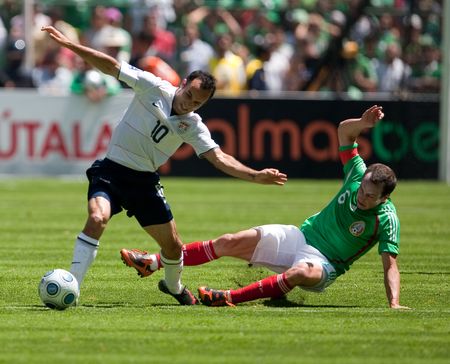Photo by ISIphotos.com
In case you haven't heard by now, CONCACAF is preparing to change its World Cup qualifying format dramatically, doing away with the old Hexagonal final qualifying round in favor of a two-group final round that gives eight teams a chance to battle for the three (or four) automatic World Cup berths the region receives.
So why will you hate it?
Under the new format, the final eight teams in CONCACAF qualifying will be placed in two four-team groups, with the winner of each group qualifying automatically and the two second-place teams playing off for the third automatic qualifying spot.
So why will you hate it?
No USA-Mexico. No trip to Azteca for the United States and no visit to frigid Crew Stadium for 'El Tri'.
Sound crazy? Too bad it's happening.
FIFA is expected to ratify the changes, which will go into effect for the 2014 World Cup qualifying cycle. U.S. Soccer president Sunil Gulati acknowledged on Tuesday that the changes are likely to go through, and his only remark about the lost USA-Mexico qualifiers was to make clear the two rivals would still find ways to play each other.
No, it won't be the same. Not even close.
The United States and Mexico could still meet in the Gold Cup, and in friendlies, but chances are they would be kept in seperate qualifying groups under the new CONCACAF format, meaning no more of the heated qualifiers that both side's fans spend years looking forward to.
So why is CONCACAF making these changes? It's making them to give more of the region's smaller teams a chance to play against the big boys. The new system will consist of three group stages (eight groups of four, then four groups of four, then a final two groups of four), up from the current system's two group stages. It will mean 32 teams will have a chance to play in a group stage, instead of the 16 that used to play in group stages. It also means eight teams have that chance to survive the final round, up from the six that have made up the Hexagonal in the past.
The changes make sense if you're from a smaller country, but for Mexico and the United States it means more games against smaller nations and likely means the elimination of the big-money qualifiers against each other. If CONCACAF sticks to a stringent seeding process, and you have to believe the region will do its best to keep Mexico and the United States away from each other, then the days of Americans making the trip to Mexico City and Mexicans braving the cold in Ohio are over.
The likely tradeoff for the region's powers is that there is less of a chance of facing an early-round group of death (which is what we saw when Mexico, Honduras, Canada and Jamaica wound up in the same second-round group in 2008). There is some added danger in that a top power getting off to a slow start in the final group could find itself forced into a playoff for a World Cup place. When you consider how slowly Mexico started in the last Hexagonal qualifying cycle it isn't out of the realm of possibility.
The bright side? If there is one it's that there will be more early-round group matches to play and potentially give experience to younger players. Chances are there will be a few cupcakes in the first group stage where Bob Bradley can give a look to some inexperienced players. It also means more qualifying matches, which could conceivably help the FIFA rankings of CONCACAF's powers.
Is that worth the tradeoff of losing USA-Mexico qualifiers? Not really, but it's the system we're facing.
What do you think of this development? Hate the changes, or are you liking the idea of three group stages?
Share your thoughts below.

